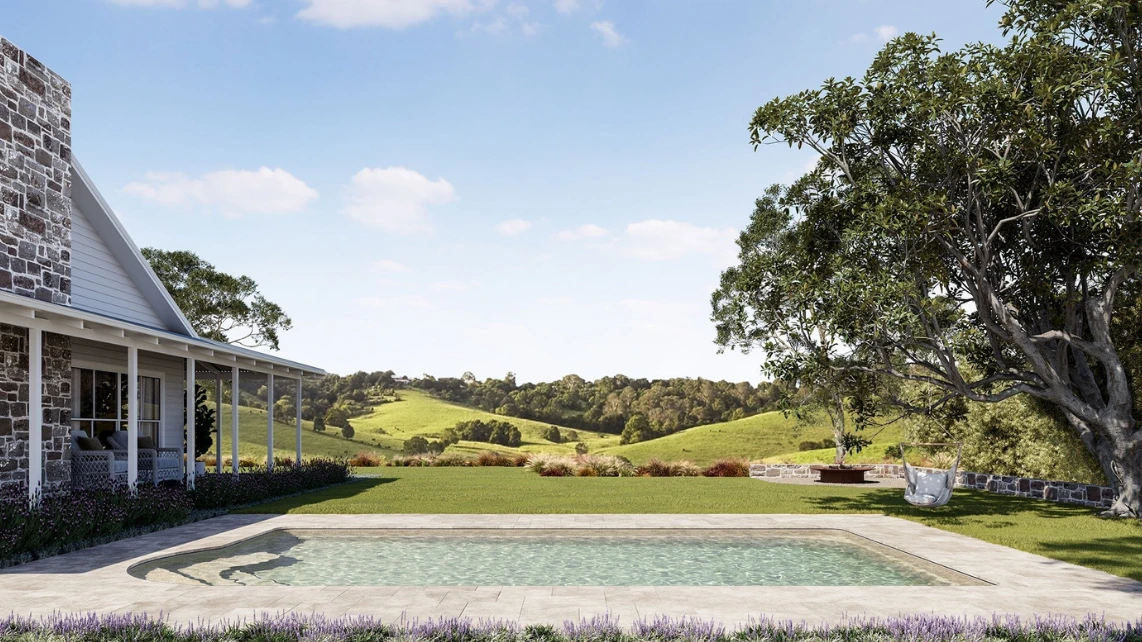Lots of people in Australia, especially in Mackay, still believe old fibreglass pool myths. You might hear scary tales about pools cracking, sliding, or being unsafe, which sometimes comes from someone who's never even owned one.
These myths can make you second-guess your choice. You may also end up thinking it's safer to forget getting one, or settle for something that isn't what you hoped for.
But the truth is, fibreglass pools have come a long way. Australian Standards are strict for everyone's safety, and pool builders know how to do the job right.
In this article, we'll bust all the myths we know so you can see what's real, what's not, and make your pool plans with confidence.
Highlights
- Many worry that fibreglass pools crack easily due to weather or ground movement, but this myth comes from old installations or bad care.
- Fibreglass pools aren't just plain rectangles; there are many shapes, colours, and options to make your pool unique and personal.
- Unlike common belief, fibreglass pools last 25 to 50 years or more with proper installation and need far less maintenance than concrete pools.
- Fibreglass pools can be safely installed in most soil types, including challenging clay or sandy soils, when soil testing and preparation are done right.
- Although some think fibreglass pools are costly and look cheap, they often cost less upfront and in the long run than concrete and come in many elegant designs.
- While pools could float if empty on soggy ground, a filled fibreglass pool with proper installation and good drainage is safe, steady, and built to stay put even in harsh rains or storms.
Myth #1: Fibreglass pools crack easily
Some people say fibreglass pools are weak. They worry the shell will crack if the ground moves or if lots of kids jump in. Others think weather, like hot sun or cool nights, can cause the pool to split.
It's easy to get scared by old photos on the internet or advice from someone who had a bad install twenty years ago. Because fibreglass shells are smooth and flexible, some folks also believe they're 'flimsy', like a plastic tub instead of a strong, lasting pool.
The Truth
Today's fibreglass pools are built tough, especially when made to the Australian Standard (AS 1838:2021) or the standard for the design and fabrication of fibreglass pools. They use several strong layers of resin and fibreglass, so the shell holds up to normal ground movement and busy swimming days.
Our partner, Harvest Pools, takes this even further. With over 35 years' experience, they carefully check every step of making the pool to meet the highest Aussie industry standards.
They start by preparing the mould to match the pool's shiny finish. Using low-styrene-emission resin means less harm to the environment while meeting strict Australian rules. The gel coat sets the perfect colour and thickness, while the vinyl ester layer keeps the pool safe from water damage. Finally, two thick layers of fibreglass make the shell tough and long-lasting.
Additionally, if you follow the proper rules for bedding (usually 7mm crushed rock) and backfilling the shell, and make sure your installer uses the right steps from fibreglass installation standard or AS 1839:2021, cracks almost never happen. Most cracking issues come from shortcuts during install, not from the shell itself.
When you use a reputable installer and follow the Standards, a fibreglass pool is safe and strong - real fibreglass strong.
Myth #2: Fibreglass pools can't be customised
A lot of people say fibreglass pools are boring. They believe you only get to pick from a few plain shapes and sizes. Some reckon there's no way to add nice steps, seats, or make it match your dream backyard.
You may even hear that every pool ends up looking the same, with no choice of colour or any way to add fun things like benches, ledges, or special lighting. If you want a pool that's truly your own, people say you have to choose concrete.
The Truth
Yes, there's a bit of truth to this myth. Unlike concrete pools, fibreglass shells are made using moulds, so you can't change the shape after it's cast. And if you want a very unusual or fully custom design, fibreglass might feel a bit limiting at first glance.
However, there are lots of different moulds available beyond simple rectangles or ovals unlike before.
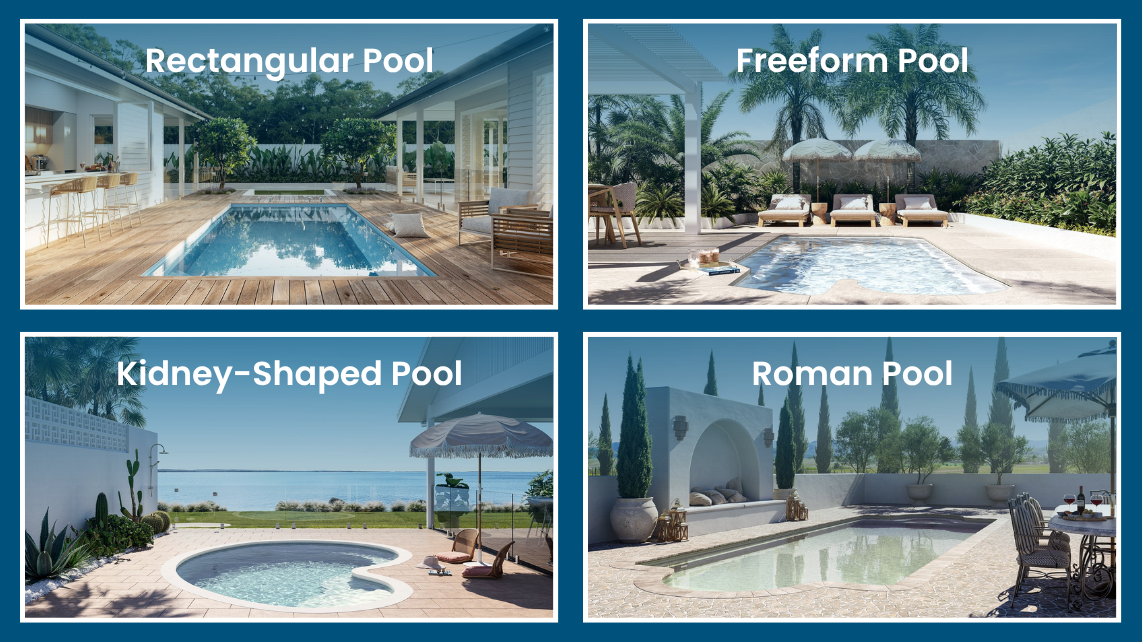
Today's fibreglass pools come in many shapes: rectangular, freeform, kidney-shaped, and Roman pools. These shapes' moulds often include built-in steps, seats, and swim-outs, so you get a range of options that suit most backyards and tastes without losing the benefits of fibreglass.
You can also pick shell colours and add features like lighting, water jets, or spa zones. Clever landscaping, pool lounges, and outdoor lighting around your pool help turn your backyard into your own relaxing retreat.
While you can't change the mould for just one pool, you still have plenty of ways to make your pool and its surroundings fit your style. Good landscaping and smart extras let you customise your pool so it feels like yours.
Myth #3: Fibreglass pools don't last as long as concrete pools
Plenty of people will tell you that fibreglass pools are weaker than concrete. You might hear that the shell wears down fast, gets brittle over time, or can't handle intense sun and splashing.
Others argue that concrete pools are always tougher and stand up to busy families and wild weather much better. And this leads folks to worry that a fibreglass pool is only a short-term choice, or something you'll have to fix or replace long before a concrete one.
The Truth
Modern fibreglass pools are built to last, often 25 to 50 years or more. According to AS 1838:2021 and AS 1839:2021, the shells must use strong resins and several layers of fibreglass for strength and durability.
With the proper installation - using correct bedding, backfill, drainage, and support - a fibreglass pool stays in top shape for decades. Good shells resist UV, chemicals, and fading. Trusted manufacturers even back up a fibreglass pool's lifetime with long structural warranties, sometimes for life, and usually guarantee the pool's internal finish for 20 years or longer.
When you follow Australian Standards for installation and maintenance, a fibreglass pool will last just as long as concrete, with less fuss required to keep it looking new.
Myth #4: Fibreglass pools can't be installed in problematic soils
Some people think you can't put a fibreglass pool in tough soils. If your backyard has clay, sand, or rocky ground, you might hear it's impossible. Lots of folks worry that the shell won't stay level, or that movement in the earth will snap or shift the pool.
This myth keeps going because people remember old stories, or hear from builders who only know about concrete. And now, plenty of homeowners still believe fibreglass is only an option for perfect, soft soil and flat blocks.
The Truth
You can install fibreglass pools in lots of soil types when you follow the AS 1839:2021. The key is knowing your backyard's soil and getting the site ready.
We can know the type of soil you have through soil testing. We recommend doing this because not every backyard soil is the same, and when you have the worst one or a reactive clay, we can plan a proper installation and subsoil drainage for your fibreglass pool.
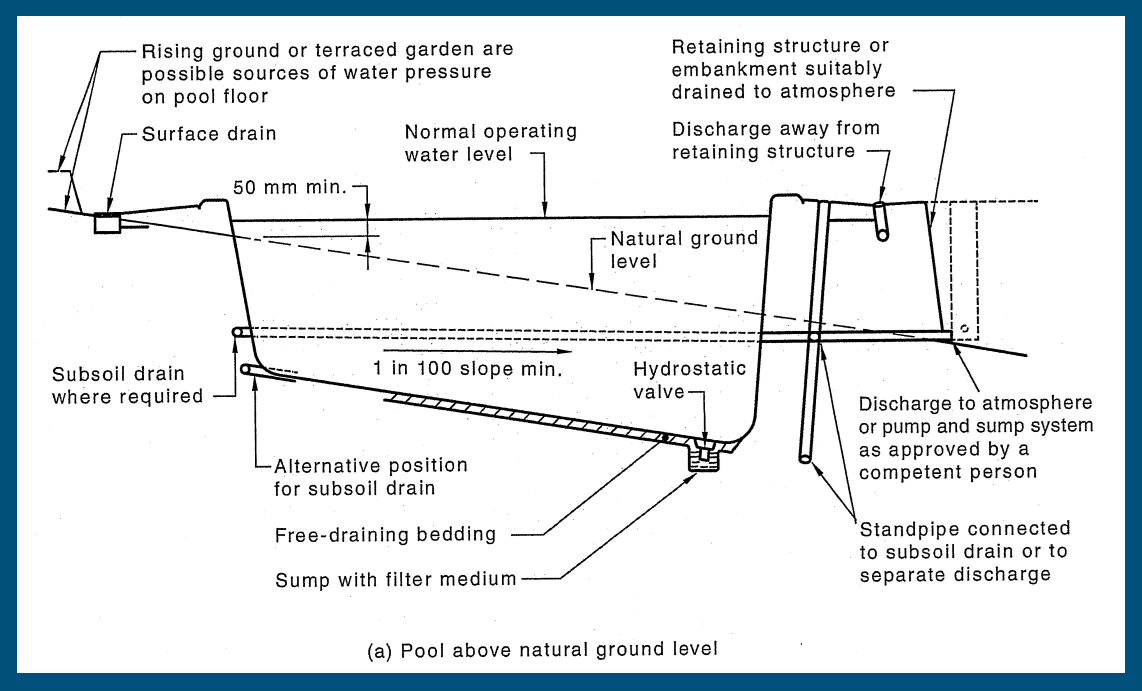 A figure from Page 12 of AS 1839:2021 showing pool drainage for installations above natural ground level.
A figure from Page 12 of AS 1839:2021 showing pool drainage for installations above natural ground level.
AS 1839:2021 explains how to manage different grounds, especially for those above natural ground level and that have reactive clay. It covers important steps like preparing the ground so it drains well and doesn't hold water under the pool. The Standard also highlights the need to protect the pool from soil movement or swelling, which can happen with clay or other reactive soils.
So with careful prep and sticking to the right rules, fibreglass pools work safely in backyards across Australia, even tricky ones with difficult soil types.
Myth #5: Fibreglass pools are expensive yet look cheap
Lots of people think fibreglass pools cost too much. They say, 'Why spend all that money and only get a plastic-looking pool?' This myth comes from old stories about pools that looked plain or faded in the sun.
Others also believe you'll pay more to install a pool and just end up with something that doesn't last or add value to your home. So, the idea keeps spreading that if you want something special, fibreglass isn't worth the cost.
The Truth
Here's a fact: while the upfront price of a fibreglass pool is often equal to or even less than a concrete pool, what sets it apart is how much you save in the long run.
Concrete pools usually need more time and money for installation, plus regular resurfacing and repairs over the years. Fibreglass, on the other hand, has a smooth shell that stays strong and neat with hardly any fuss. For maintenance, you also spend less money on chemicals and less time on cleaning fibreglass pools because algae finds it hard to stick to the surface.
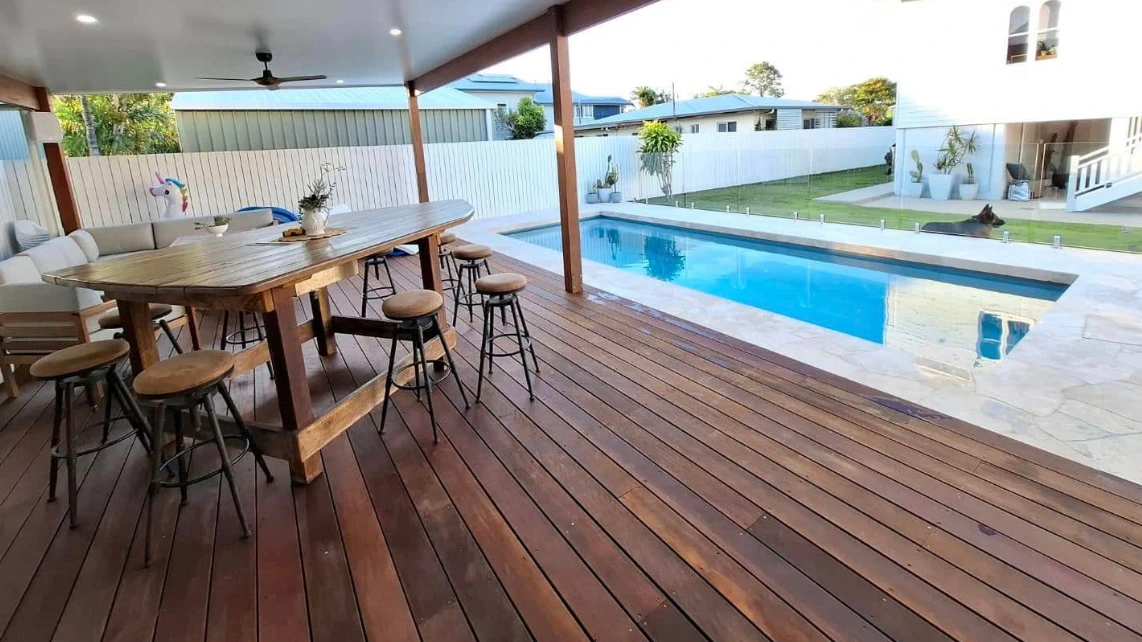
When it comes to style, modern fibreglass pools look anything but cheap. They come in a range of rich colours, shapes, and glossy finishes that can be just as eye-catching as concrete, and sometimes even more so.
You can choose from slim lap pools, pretty plunge pools, or sweeping curved shells. With features like built-in steps, benches, waterfall edges, and clever lighting, a fibreglass pool fits beautifully into any backyard design.
If you would like to learn more about the additional costs to consider, click here to check our blog post that outlines initial, ongoing, and add-on costs for fibreglass pool installation in Mackay.
Myth #6: Fibreglass pools float or pop out of the ground
Some people worry that a fibreglass pool will float up or pop right out of the ground after rain. You may hear stories about empty pools pushing out of the earth if the ground gets soggy.
There are rumours that fibreglass shells are too light, so they can't stay in place like concrete. They tend to end up choosing concrete pools. Their preference is not the problem, but it is the fact that this is always being linked to fibreglass pools, and families end up making a rushed decision.
The Truth
In all honesty, there's actually a bit of truth to this one, but only in very rare cases. If a fibreglass pool is left empty and the ground around it is soaked, there's a chance it could rise up or move. This can happen because water in the soil tries to push against the empty shell.
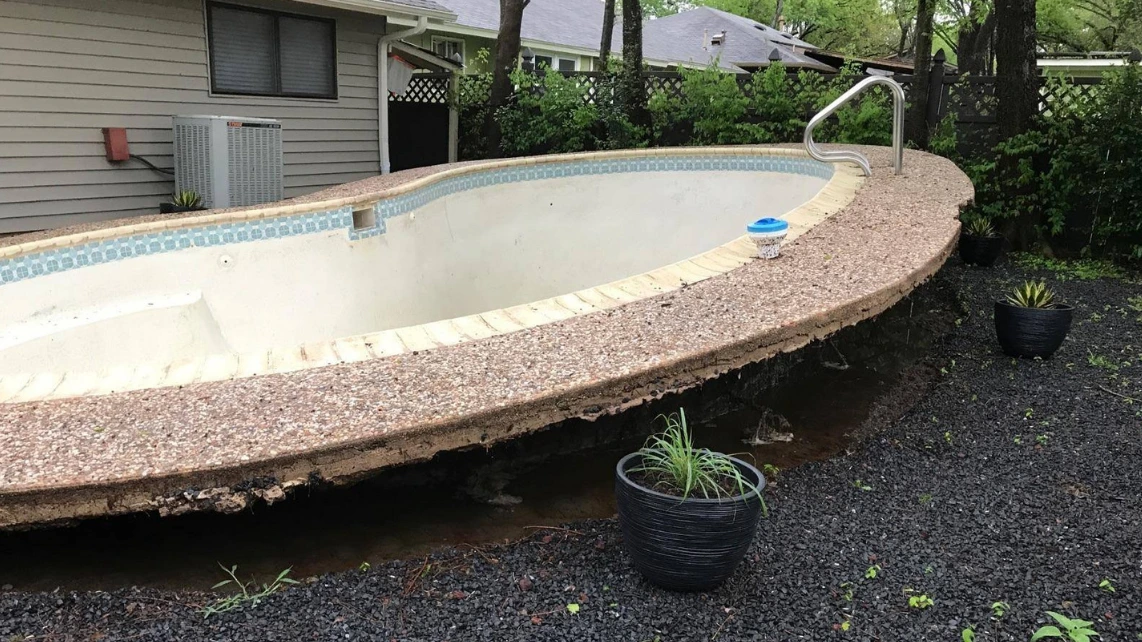 An image of a fibreglass pool that has popped out of the ground due to groundwater and saturated soil. Source: reddit.com
An image of a fibreglass pool that has popped out of the ground due to groundwater and saturated soil. Source: reddit.com
But here's the catch: when your pool is installed properly and always kept full of water, it stays safe and steady in the ground. The weight of the pool water pushes down on the pool shell, stopping it from moving even after heavy rain. Plus, good drainage around the pool helps keep extra water away from the shell.
Removing the water can risk the pool shell moving or popping up, especially after rain. Even if you have a good reason to drain your pool, like it has become dark green due to algae, always ask your pool builder or installer what to do. They can advise alternatives like shock treatment in that case.
Fibreglass pools stay put even during wild storms. A pool only 'floats' when empty and the ground is soggy, so as long as you follow the installer's care notes and don't empty the pool without professional help, you won't have anything to worry about.
Myth #7: Fibreglass pools do work in warm climates only
Some people say fibreglass pools are no good unless you live up north where it's sunny all year. They reckon the shells will crack or get damaged if it ever freezes or gets cold.
You might also hear that fibreglass is only for places like Queensland and doesn't suit cooler spots like Victoria or country NSW. Until now, some still worry that the pool shell can't handle frosts, or that cold snaps will make it go brittle and break.
The Truth
Fibreglass pools are designed to handle all sorts of weather. The strong, flexible pool shell can cope with freezing as well as the hottest days without cracking or losing its colour. These pools won't go brittle in winter or soften when the sun comes out.
If you live where it only gets a little chilly, simple steps like using a good pool cover and running the pump every day help keep everything in great shape. Always ask your pool installer or maintenance pro about the best way to winterise your setup. They'll have tips for your local weather.
Myth #8: Fibreglass pools are too slippery and unsafe
Some people say fibreglass pools are just like a slippery slide. They think you'll lose your footing every time and that it's not safe for kids or older family members.
Lots of folks think the pool has a smooth, glassy surface, making it easy to fall over or get hurt, especially when someone's running or playing.
The Truth
Maybe people get confused with the term 'fibreglass', so they think of a glassy surface, but the fibreglass part of the pool shell is in the middle layer, not the one you can feel with your feet, which is the gel coat. Or it can also be the gel coat that they're worried about.
Modern fibreglass pools are designed so you can enjoy swimming safely with friends and family, all thanks to their textured surfaces. Even though the inside is all covered with the gel coat, the steps, benches, and pool floor aren't left slick and shiny.
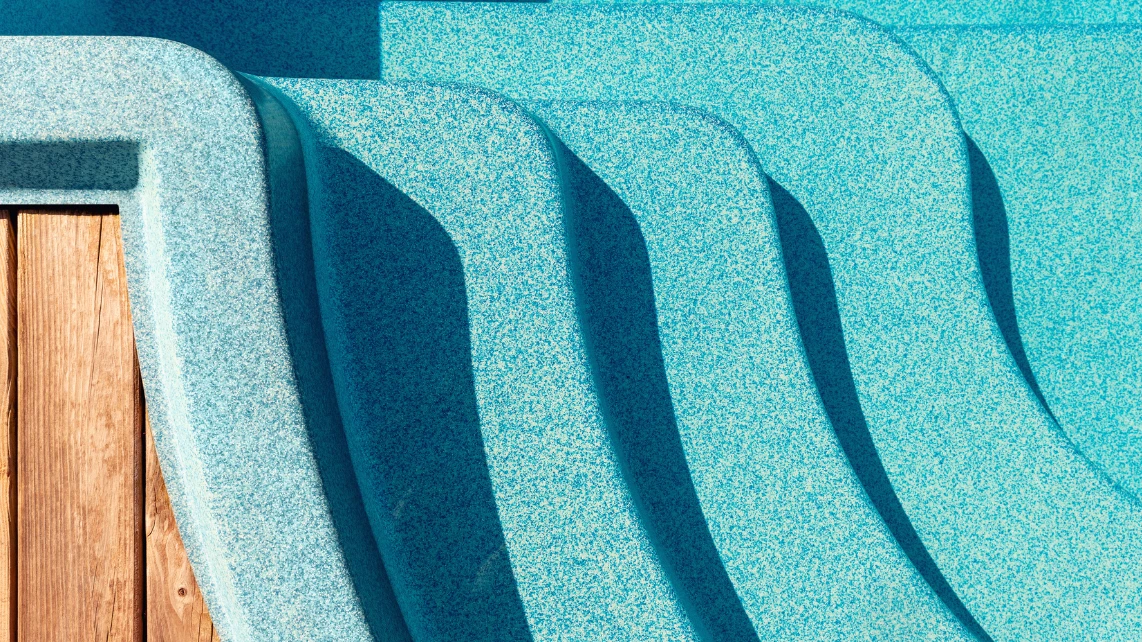
Instead, they get a special textured finish that gives your feet proper grip, even when everything's wet. This is done during the manufacturing process, so every step and seat feels a bit grippy, not smooth like a bath.
Families find these pools feel gentle underfoot. No sharp bits or rough patches to scratch your skin or stub your toes. That's why parents often say it's easier for kids to get in and out, and everyone can stand or sit comfortably without worrying about falling over.
Final Thoughts
Choosing a fibreglass pool doesn't have to be scary. There are plenty of myths out there, but when you know Australian Standards, check facts and rumours, and get the right team, your pool will be safe, strong, and easy to enjoy for years to come.
When you're unsure or stuck, always ask a licensed pool builder or installer about the steps they follow and the products they use. The right answers always come from real experience and proper rules, not hearsay online.
If you ever need help with your fibreglass pool project, just reach out to us. We are licensed installers with years of experience installing fibreglass pools in Mackay, and we're happy to chat or give you a quote.
And if you're still thinking about which fibreglass pool to choose, check out the fibreglass pool designs our partner offers. There's always something for every backyard and budget.

